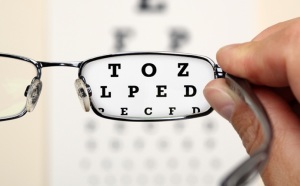Myopia – Back to Basics
Myopia
We are looking at refractive errors this week as we continue on with our back to basics series for 2017. As discussed yesterday in our refraction overview, a refractive error means that the eye does not bend or refract light properly to see images clearly or in focus. Today we are looking at Myopia, otherwise referred to as short sightedness, or near sightedness. In Myopia, close objects look clear but objects in the distance appear blurred.
What is Myopia?
Myopia is a common type of refractive error. In a myopic eye, the eyeball is usually too long (when measured from the cornea at the front to the retina at the back). This causes light rays to focus at a point in front of the retina rather than directly on its surface. This makes distant objects blurry. If you have perfect vision, the rays focus directly on the surface of the retina:
What are the symptoms of Myopia?
Myopic people have trouble seeing objects in the distance but are able to see nearby objects clearly. Myopic people will often require glasses for driving but are able to read without their glasses, depending on the degree of their myopia. Sometimes, people with untreated myopia will have headaches and eye strain to see things in the distance clearly.
Myopia in Children
Myopia is inherited and often detected in children between the ages of 8 and 12 years old. During teenage years when puberty occurs, myopia may become worse. Often, by the time the child reaches adulthood, during their 20’s, the myopic prescription tends to plateau with little change. It is possible for myopia to occur in adults, however this is less common than childhood diagnosis.
High Myopia
We refer to myopic patients with a high / severe degree of myopia as ‘high myopes’. In these cases, the eyeball continues to grow and becomes very long from front to back. As a result, consistent increases in the glasses prescription is experienced throughout childhood however this normally stabilises by adulthood during mid to late 20’s. High myopia can normally be corrected by glasses, contact lenses or in some cases refractive surgery. Patients with high myopia have an increased risk of developing a retinal detachment, glaucoma or cataracts.
How is Myopia diagnosed?
Your ophthalmologist can diagnose Myopia as part of a comprehensive eye examination; he or she will carry out a standard vision test then perform a refraction whereby the prescription, or level of myopia is measured. If necessary, your ophthalmologist will provide you with a prescription for glasses to correct your myopia which you can then take to your local optometrist.
How is Myopia treated?
The most common way to treat myopia is with glasses or contact lenses. Once the eyes have stopped growing, refractive surgery may also be a possibility for some people.
Glasses use curved lenses to refocus light rays onto the cornea
Contact Lenses correct vision in the same way as glasses, only they are placed directly onto the eye.
Refractive Surgery changes the shape of the cornea, by ‘ablating’ or removing corneal tissue to correct myopia. There are different types of surgery but the most common are LASIK and PRK.
References:
https://www.aao.org, https://nei.nih.gov



